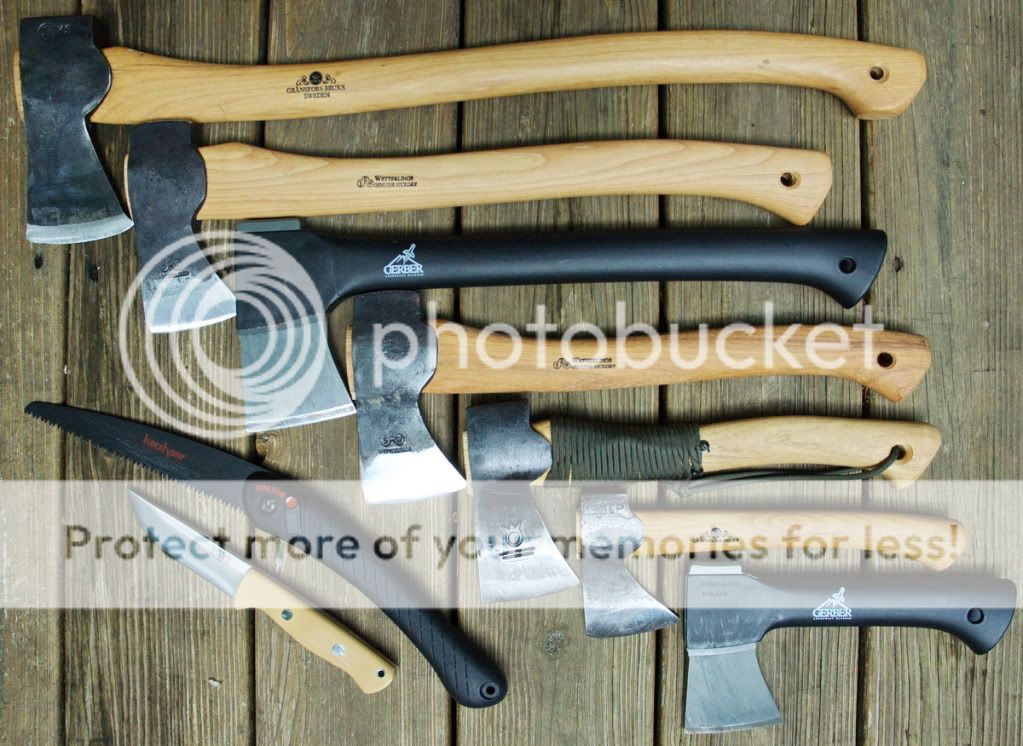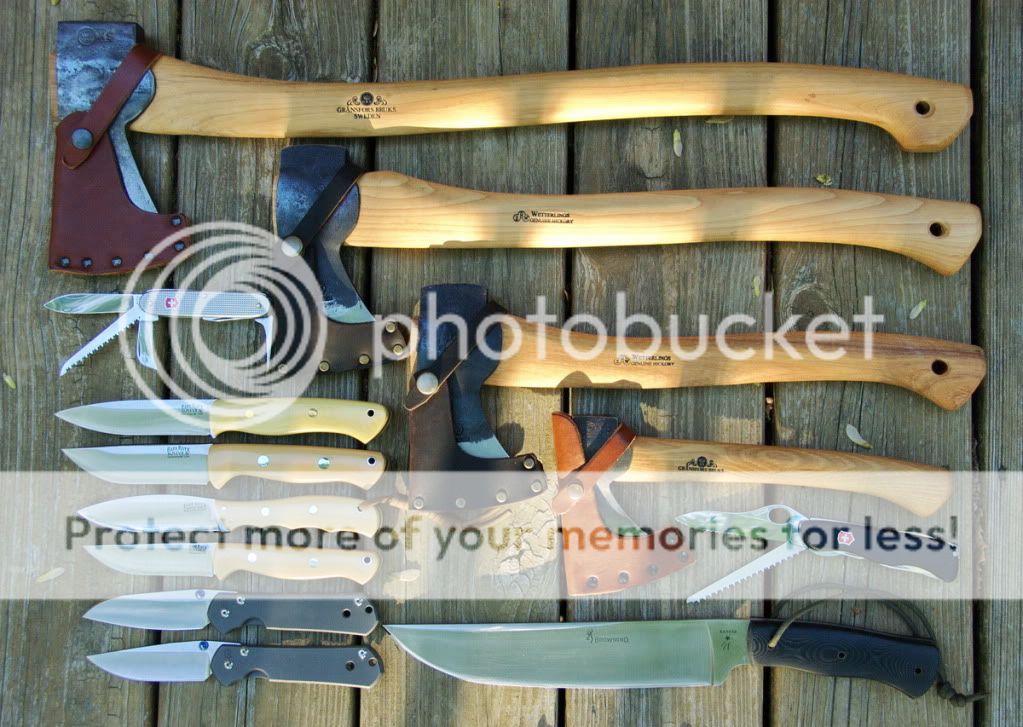Last Visible Canary
actively parsing hurf durf
- Joined
- Nov 28, 2006
- Messages
- 4,577
Got a basic 10 in the mail yesterday 
Top to bottom: cs ttkz, b10, proto boss jack, scrap yard scrapivore

It's a really nice knife. Several people have said that they feel glad to have passed it up and kept the basic 11, or are keeping the basic 11 over it. I'm the opposite, I'm happy with having sold the b11 and gotten this. It's thinner, lighter, not quite as long, but with an equal amount of edge. I don't have any major problems with it at all, across the board. With the basic 11 I could also say "If only it didn't have a choil". While the basic 11 is a better chopper than this, it's a better chopper with a few small compromises, depending on what you want out of your knife. It's got a thicker edge, it's got a choil, it doesn't have as much belly, it's heavier, it's got a (slightly) thinner harder feeling handle. The b10 is lighter, has the same amount of edge, has a slightly softer slightly thicker handle, it has no snag points when chopping hard at vines or over expending your reach on branches, it's got a thinner edge, and it feels closer to being a heavy machete than a dedicated shopper.

one of the other major differences is the spine. The basic 11 has a simple machinists style edge break of around .010", meaning someone took a file to the corner so it wouldn't be a razor sharp 90 degree edge that could cut you if you grabbed it. The result is a less-comfortable chocked up grip for skinning/other tasks, but it does have another advantage.
totally flat compared to something like the TTKZ's nuclear meltdown treatment:


.010" machinists edge break:

less comfortable with the sharp edges, but tolerable, especially with gloves of any sort:

The basic 10 also doesn't have the straight edge at the tip:

why would you ever want a sharp edge? heres an aluminum/ferro rod block with 3 edged tools. A small saw provided with the block, a carbide striker from usaknifemaker, and the b10.

the saw creates fine powder and throws it everywhere, hard to make a pile, it also eats up the block making it jagged


The carbide striker is by far the best, creating nice curly q's in a controlled pile


this is what you get when you leave an unbroken edge on a high hardness steel or carbide, an edge that can be used to scrape or cut as though it were a knife,

The basic 10 didn't fair as well, but definitely better than the saw. It created crescents in a controlled pile. Even with a .010" edge break, it's still sharp enough to scrape and strike with.


The edge is a heavy rounded convex. I haven't checked what the actual edge angle is, but I know I'll be creating a heavy relief bevel to get it down to where I want it. Not as wide as the b11, but still it's thicker than I want.


A chart showing the thinner overall grind compared to the basic 11, and much thinner compared to the csTTKZ. The measurements are taken at the center of the main cutting edge, where you are most likely to chop wood at:

The taper on the spine is very long, starting at 3.5" back from the tip. At 3.5" it's .220" thick, and the taper starts noticably at 2" back where it's at .205". To give you an idea of why this is significant, busse tends to thicken up their tips a lot. Like.... a lot. The tip on the basic 10 is actually thinner than the main grind of the basic 11.
Measurements for the tip (not included in the chart since I didn't take it for the others):\
1/16" - 0.042"
1/8" - 0.058"
1/4" - 0.080"
3/8" - 0.095"
1/2" - 0.112
5/8" - 0.123"
3/4" - 0.138"
7/8" - 0.148"
1" - 0.157"
I'm really happy to see Busse Combat using a plastic safety netting on their knives for shipment. It's not wire or anything, it's just thin plastic, but it's cut resistant on a static knife (i.e. your not trying to cut through it, the knife is just resting it it) so that if it bashes the edge of the box it's unlikely to cut through it. It's a really cool idea.



Overall I'm very happy with the basic 10. It's what I wanted out of the basic 9 and 11 but couldn't get, and thus did not feel bad about selling both of them. The basic 11 is a better chopper, but I don't feel that it's a better all around knife. The basic 10 feels streamlined, slightly less tall (even though it's only by 1/16" or so), with no wasted space anywhere. It feels like a light machete instead of a dedicated chopper. It just feels good, and has a nice balance between thinness at the edge and extremely high durability. Over the last 8 or 9 years I've slowly progressed to where I actually don't want to own choiled knives, even in the chopper catagory. I have no need to lose the edge space, and now I have options form busse combat.
Top to bottom: cs ttkz, b10, proto boss jack, scrap yard scrapivore

It's a really nice knife. Several people have said that they feel glad to have passed it up and kept the basic 11, or are keeping the basic 11 over it. I'm the opposite, I'm happy with having sold the b11 and gotten this. It's thinner, lighter, not quite as long, but with an equal amount of edge. I don't have any major problems with it at all, across the board. With the basic 11 I could also say "If only it didn't have a choil". While the basic 11 is a better chopper than this, it's a better chopper with a few small compromises, depending on what you want out of your knife. It's got a thicker edge, it's got a choil, it doesn't have as much belly, it's heavier, it's got a (slightly) thinner harder feeling handle. The b10 is lighter, has the same amount of edge, has a slightly softer slightly thicker handle, it has no snag points when chopping hard at vines or over expending your reach on branches, it's got a thinner edge, and it feels closer to being a heavy machete than a dedicated shopper.

one of the other major differences is the spine. The basic 11 has a simple machinists style edge break of around .010", meaning someone took a file to the corner so it wouldn't be a razor sharp 90 degree edge that could cut you if you grabbed it. The result is a less-comfortable chocked up grip for skinning/other tasks, but it does have another advantage.
totally flat compared to something like the TTKZ's nuclear meltdown treatment:


.010" machinists edge break:

less comfortable with the sharp edges, but tolerable, especially with gloves of any sort:

The basic 10 also doesn't have the straight edge at the tip:

why would you ever want a sharp edge? heres an aluminum/ferro rod block with 3 edged tools. A small saw provided with the block, a carbide striker from usaknifemaker, and the b10.

the saw creates fine powder and throws it everywhere, hard to make a pile, it also eats up the block making it jagged


The carbide striker is by far the best, creating nice curly q's in a controlled pile


this is what you get when you leave an unbroken edge on a high hardness steel or carbide, an edge that can be used to scrape or cut as though it were a knife,

The basic 10 didn't fair as well, but definitely better than the saw. It created crescents in a controlled pile. Even with a .010" edge break, it's still sharp enough to scrape and strike with.


The edge is a heavy rounded convex. I haven't checked what the actual edge angle is, but I know I'll be creating a heavy relief bevel to get it down to where I want it. Not as wide as the b11, but still it's thicker than I want.


A chart showing the thinner overall grind compared to the basic 11, and much thinner compared to the csTTKZ. The measurements are taken at the center of the main cutting edge, where you are most likely to chop wood at:

The taper on the spine is very long, starting at 3.5" back from the tip. At 3.5" it's .220" thick, and the taper starts noticably at 2" back where it's at .205". To give you an idea of why this is significant, busse tends to thicken up their tips a lot. Like.... a lot. The tip on the basic 10 is actually thinner than the main grind of the basic 11.
Measurements for the tip (not included in the chart since I didn't take it for the others):\
1/16" - 0.042"
1/8" - 0.058"
1/4" - 0.080"
3/8" - 0.095"
1/2" - 0.112
5/8" - 0.123"
3/4" - 0.138"
7/8" - 0.148"
1" - 0.157"
I'm really happy to see Busse Combat using a plastic safety netting on their knives for shipment. It's not wire or anything, it's just thin plastic, but it's cut resistant on a static knife (i.e. your not trying to cut through it, the knife is just resting it it) so that if it bashes the edge of the box it's unlikely to cut through it. It's a really cool idea.



Overall I'm very happy with the basic 10. It's what I wanted out of the basic 9 and 11 but couldn't get, and thus did not feel bad about selling both of them. The basic 11 is a better chopper, but I don't feel that it's a better all around knife. The basic 10 feels streamlined, slightly less tall (even though it's only by 1/16" or so), with no wasted space anywhere. It feels like a light machete instead of a dedicated chopper. It just feels good, and has a nice balance between thinness at the edge and extremely high durability. Over the last 8 or 9 years I've slowly progressed to where I actually don't want to own choiled knives, even in the chopper catagory. I have no need to lose the edge space, and now I have options form busse combat.
Last edited:














